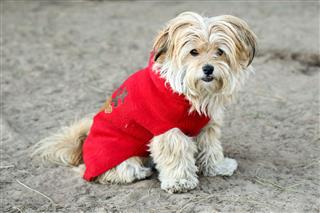
Most people who suffer from allergies and want to pet dogs prefer breeds that don’t shed. This article is a quick guide to some popular less shedding dog breeds available in large, medium and small sizes.
Before we proceed any further, it is important to know that there are no such dog breeds that don’t shed at all. Cows moo, cats mew, donkeys bray, and dogs shed! Shedding is a natural part of a dog’s life. These animals do not grow hair continuously, unlike we humans. The growth takes place in cycles in various stages; growing stage, shedding stage, and resting stage. During the late summer months, the growing stage kicks off, and shedding takes place during late spring.
It is during the early fall months, when the resting stage is on, and this is when the shedding is at its minimum. Now all these stages are influenced greatly by factors such as change of seasons, light exposure, health, and stress. The main purpose of shedding is to get rid of dead hair, which gets replaced by new hair.
The only difference is that some dogs shed more while some too less to be bothered about. And this article speaks of the latter type, that is dogs that are ‘light shedders’.
Dogs that Shed Less
Most people prefer large breed dogs, while some like the company of the small ones. And there are people like me, who settle for medium-sized canines. So the below lists present to you the names of less shedding dogs while classifying them according to their sizes as well.
Small Dog Breeds
- American Hairless Terrier
- Australian Silky Terrier
- Australian Terrier
- Basenji
- Bedlington Terrier
- Bichon Frise
- Bolognese
- Border Terrier
- Brussels Griffon
- Cairn Terrier
- Chacy Ranior
- Chinese Crested Dog
- Coton de Tulear
- Dandie Dinmont Terrier
- Hairless Khala
- Maltese
- Maltipoo
- Manchester Terrier
- Mexican Hairless (Toy)
- Miniature Poodle
- Miniature Schnauzer
- Morkie
- Norfolk Terrier
- Norwich Terrier
- Petit Basset
- Griffon Vendeen
- Schnoodle
- Scottish Terrier
- Shichon
- Shih-Tzu
- Toy Fox Terrier
- Welsh Terrier
- West Highland White Terrier
- Yorkie Poo
- Yorkshire Terrier
Medium Dog Breeds
- American Water Spaniel
- American Cocker Spaniel
- Belgian Shepherd Dog
- Chinese Shar-Pei
- Doodleman Pinscher
- English Cocker Spaniel
- Hungarian Puli
- Irish Water Spaniel
- Kerry Blue Terrier
- Lagotto Romagnolo
- Mexican Hairless
- Peruvian Hairless
- Polish Lowland Sheepdog
- Poodle
- Pumi
- Sealyham Terrier
- Sheepadoodle
- Soft Coated Wheaten Terrier
- Spanish Water Dog
- Tibetan Terrier
- Wirehaired Fox Terrier
Large Dog Breeds
- Airedale Terrier
- Bergamasco
- Black Russian Terrier
- Bouvier des Flanders
- Giant Schnauzer
- Komondor
- Spanish Water Dog
An important point to make a note of is that such dogs are high on maintenance when it comes to their grooming needs. Here are some tips that owners can follow, in order to keep shedding as low as possible.
Brushing the dog’s hair with a slicker brush helps remove loose fur that may otherwise collect and tangle up in mats. Apart from a slicker brush, a shedding comb is also preferable. Ensure that this is done on a weekly basis.
Bathing is also an important aspect of dog care. A good bath twice a month promotes good air circulation to the scalp, and helps in removing more dead hair from the coat. You can also use a vacuum hose to remove loose fur from the coat. Take care that the hose is kept at a safe distance from the dog’s body.
Certain kinds of diseases affect dogs’ skin and coat, and shedding could be one of the common symptoms. So regardless of the breed you own; it is a must for regular health checkups. Feeding appropriate food (containing good digestible protein sources) to your pets also helps in reducing excess shedding.
To conclude with some useful information related to this subject, as mentioned, most people prefer dogs that shed less because of their allergy concerns. Hypoallergenic dogs, as they are known as, are those which are considered to suit better to people who are allergic to these animals. However, the existence of such dogs is still a debatable topic, as some studies support it, while some don’t. According to scientists, the proteins that are found in the saliva of the animal, and small scales from its skin (dander) is the main cause of causing allergic reactions in people. And since such proteins can easily latch onto the hair of the animal, more shedding creates more chances of allergens being released into the atmosphere. So some scientists are of the view that even a hairless dog can cause allergy in sensitive people. Having said that, the allergy factor may depend on the individual dog and the person owning it, and not particularly the breed of the animal.





























